 You probably got the message by now that we strongly feel that one of the best ways to reduce chronic stress is to practice conscious relaxation (see The Relaxation Response and Yoga). But with the exception of Supported Inverted Poses, all the other techniques for practicing relaxation that yoga provides require that you either lie or sit still for an extended period of time. And when you’re feeling stressed out or anxious, sometimes the last thing you feel like doing is staying still!
You probably got the message by now that we strongly feel that one of the best ways to reduce chronic stress is to practice conscious relaxation (see The Relaxation Response and Yoga). But with the exception of Supported Inverted Poses, all the other techniques for practicing relaxation that yoga provides require that you either lie or sit still for an extended period of time. And when you’re feeling stressed out or anxious, sometimes the last thing you feel like doing is staying still!With that in mind, I’ve created this sequence to help prepare you for Savasana. This active, balanced practice will help release held physical tension from your body, allowing you to physically relax when you finally lie down. And by practicing strong standing poses, which you hold for long periods of time, you will hopefully tire yourself out enough so that by the time Savasana comes around, you’ll be glad to lie down!
If you want to practice for a longer period of time, you could really tire yourself out by practicing all the standing poses two times.
Preparing for Savasana
1. Upward Bound Hands (Urdva Baddha Hastasana), 1 minute per side. Start by standing in Mountain pose, with your feet about hips-width apart. Now, interlace your fingers and turn your palms toward your feet. Strengthen your legs, pressing from your hips into your feet. Then, on an inhalation, bring your arms forward and up. Lengthen your spine and lift your collarbones as your lift your shoulder blades. Move your arms toward a vertical position, keeping your head in a neutral position. Once you encounter resistance in your shoulders or upper back, resist the impulse to take your arms further back. To come out of pose, lower your arms forward and down before releasing the clasp of your hands.
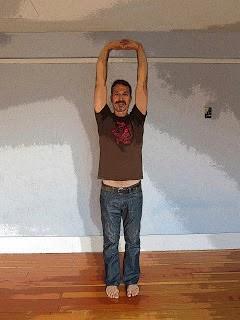 To repeat on the second side, change the interlacing of your fingers your habitual, comfortable position to the “other side.” Then repeat the instructions above. See Featured Pose: Upward Bound Hands for more information on the pose and for alternatives.
To repeat on the second side, change the interlacing of your fingers your habitual, comfortable position to the “other side.” Then repeat the instructions above. See Featured Pose: Upward Bound Hands for more information on the pose and for alternatives.2. Warrior 2 Pose, 1 to 2 minutes per side. From Mountain pose, step your feet wide apart. Turn your right foot out 90 degrees, then, pivoting on the ball of your back foot, shift your left heel back an inch or two to your left so the foot is slightly turned in.
Next, inhale and raise your arms up so they are parallel to the floor, with your palms facing down toward the floor. Keep your shoulder blades relaxed and moving down your back (not sliding up toward your ears) as you raise your arms. Then, on an exhalation, bend your right knee directly over your right ankle while keeping your torso centered over your pelvis (not leaning over your front leg). Allow your hips to rotate slightly toward your right knee but rotate your chest away from your right knee so your chest faces directly forward. Finally, allow your head and neck to turn so you gaze over your right hand.
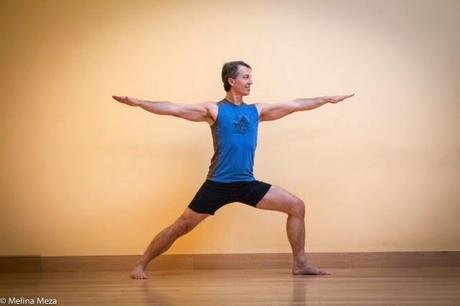 To come out of the pose, straighten your front leg and turn your feet to parallel while keeping your arms raised. Repeat on the other side. For more information, see Featured Pose: Warrior 2 Pose
To come out of the pose, straighten your front leg and turn your feet to parallel while keeping your arms raised. Repeat on the other side. For more information, see Featured Pose: Warrior 2 Pose 3. Tree Pose (Vrksanasana), 1 to 2 minutes per side. Start in Mountain Pose with your feet a bit closer together than usual. Shift your weight onto your left leg and bend your right knee a bit, coming onto the big toe of your right foot. Swing your right knee out to the right about 45 degrees. Then lift your right foot off the ground, and use your right hand to bring the sole of your right foot against your upper, inner left thigh, keeping your right knee turned out. Press your right foot firmly into your left thigh as you press your inner thigh firmly toward your foot your foot. Lengthen your spine up away from the press of your bottom foot into the floor, and see if you can then take your arms out to your sides parallel with the floor. Keep your gaze relaxed and on the horizon in front of you. If you are still feeling steady, take your arms overhead.
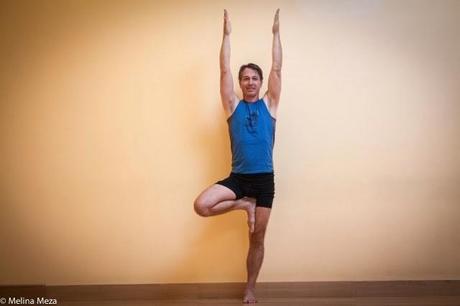 To come out of the pose, release your arms and then bring your right foot back into Mountain Pose. Repeat on second side. If this pose is not accessible to you, see Easy Balance Practice for an easier version of this pose.
To come out of the pose, release your arms and then bring your right foot back into Mountain Pose. Repeat on second side. If this pose is not accessible to you, see Easy Balance Practice for an easier version of this pose.4. Extended Side Angle Pose (Utthita Parsvakonasana), 1 to 3 minutes per side. From Mountain Pose, step your feet wide apart, about the length of your legs. Then turn your right foot out about 90 degrees and your left foot in slightly, so the pinky edge of your left foot lines up with the long edge of your yoga mat. Inhale and extend your arms out to your sides.
Exhale and bend your right knee toward 90 degrees, making sure your right knee is aligned with the middle toe of your right foot. Then, keeping your front knee directly over your front ankle, side-bend your torso out over your front thigh, and place your right hand on the floor to the outside of the front foot or on a block that is up against your right shin. Try to keep the right and left sides of your chest even with each other.
Keeping your hips stable, rotate your upper belly and chest slightly up away from your right leg. Bring your left arm overhead in line with your back leg and the side of your chest. Then, turn your head and gaze up to look under your left armpit, look straight ahead, or look down at your right foot.
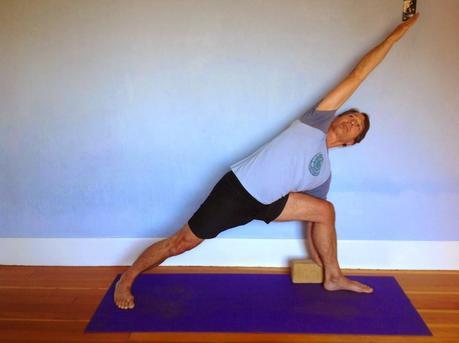 To come out of the pose, inhale as you straighten your right leg and use your left arm to swing your torso back to center, with your arms out to the side. Then, on exhalation, release your arms and turn your feet to parallel. Repeat the pose on your left side. For more information, see Featured Pose: Extended Side Angle.
To come out of the pose, inhale as you straighten your right leg and use your left arm to swing your torso back to center, with your arms out to the side. Then, on exhalation, release your arms and turn your feet to parallel. Repeat the pose on your left side. For more information, see Featured Pose: Extended Side Angle.5. Standing Forward Bend (Uttanasana), 1 to 2 minutes. From Mountain pose, place your hands on your hips and, on an exhalation, begin to bend forward from your hip joints. When your pelvis won’t rotate over your upper leg bones any more, allow your spine to round gently into a full forward bend, as you release your arms toward the floor. If your hands easily make it to the floor, walk your fingers back toward your toes, bringing them in line with your toes if possible. But if your hands fall shy of the floor, don’t force them down; instead place your hands on opposite elbows. Bend your knees a little bit if your lower back or hips feel strain or pain.
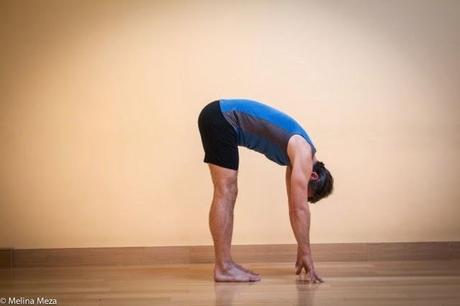 6. Triangle (Trikonasana), 1 to 3 minutes per side. From Mountain pose, step your feet wide apart, about the length of your legs. Spinning on your right heel pad, turn your right foot and leg out 90 degrees toward the right short edge of your mat. Next, pivoting on the ball of your left foot’s big toe, kick back your left heel an inch or two towards the left short edge of your mat. After you’ve established your feet, inhale and take your arms up and out to your sides, parallel with the floor. As you exhale, lift up and over your right hip joint to reach your right arm straight out over your front leg. Then, keeping your legs strong, side-bend as you bring your right hand to the floor or to a prop, depending on your flexibility.
6. Triangle (Trikonasana), 1 to 3 minutes per side. From Mountain pose, step your feet wide apart, about the length of your legs. Spinning on your right heel pad, turn your right foot and leg out 90 degrees toward the right short edge of your mat. Next, pivoting on the ball of your left foot’s big toe, kick back your left heel an inch or two towards the left short edge of your mat. After you’ve established your feet, inhale and take your arms up and out to your sides, parallel with the floor. As you exhale, lift up and over your right hip joint to reach your right arm straight out over your front leg. Then, keeping your legs strong, side-bend as you bring your right hand to the floor or to a prop, depending on your flexibility.Keeping your hips in their new location (don’t let them spin up!), rotate your upper belly and chest around the axis of your spine toward the long edge of the mat and possibly a bit more skyward, as you bring your top arm in line with your bottom arm.
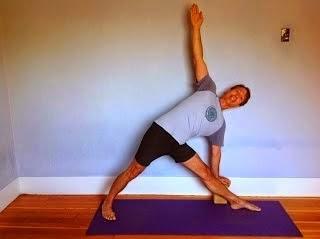 To come out of the pose, keep the strong, grounded feeling in your legs, and then on an inhalation, pivot your hips and torso back to vertical as you use your top arm to lift yourself up and out of the pose. Release your arms to your sides and bring your feet back to parallel.
To come out of the pose, keep the strong, grounded feeling in your legs, and then on an inhalation, pivot your hips and torso back to vertical as you use your top arm to lift yourself up and out of the pose. Release your arms to your sides and bring your feet back to parallel.See Featured Pose: Triangle Pose for more detailed instructions on moving into, being in, and coming out this pose.
7. Downward-Facing Dog Pose (Adho Mukha Svanasana)1 to 3 minutes. Wish we had some instructions on this pose! But at least I can rest assured this pose is so commonly taught, most of you will have some idea of how to do it. So, for now, from hands and knees position, come up into the classic Downward-Facing Dog pose. If the classic version of the pose is not accessible to you due to injuries or other problems, see Downward-Facing Dog Variations for variations.
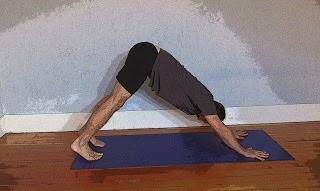 8. Warrior 1 Pose (Virabrdarasana 1), 1 to 2 minutes. Starting in Mountain pose, step your feet about three feet apart and place your hands on your hips. Spin your right foot out 90 degrees. Then lift your back heel, pivot on the ball of your foot, and spin your back heel back about four or five inches. Next, rotate your hips and chest in the same direction as your right foot. Don’t force your hips to square with the wall you are facing. Instead, allow your left hip to turn slightly toward your back leg, but square your head and your torso, from the navel on up, with your front foot. Maintain a straight strong back leg throughout.
8. Warrior 1 Pose (Virabrdarasana 1), 1 to 2 minutes. Starting in Mountain pose, step your feet about three feet apart and place your hands on your hips. Spin your right foot out 90 degrees. Then lift your back heel, pivot on the ball of your foot, and spin your back heel back about four or five inches. Next, rotate your hips and chest in the same direction as your right foot. Don’t force your hips to square with the wall you are facing. Instead, allow your left hip to turn slightly toward your back leg, but square your head and your torso, from the navel on up, with your front foot. Maintain a straight strong back leg throughout. Now, release your arms to your sides and turn your palms to face each other. Keeping your palms facing each other, inhale your arms forward and up. If your shoulders are tight, don’t worry about your arms being exactly vertical. But do keep your arms parallel—don’t try to bring your hands together. On your next exhale, bend your front knee so it is directly over your ankle joint. Do not lean forward or back, but keep your torso directly over your pelvis.
 As you breathe in the pose, encourage your outer outer shoulder blades to lift with your arms, while keeping the upper inner corners of your shoulder blade moving down your back (so the sides of your neck are relaxed and long). Keep your arms active and bring your awareness to your elbows, making sure they are not bent, and reach through both sides of your elbow joints. Stay in the pose for 30 seconds and gradually work up to longer periods of time.
As you breathe in the pose, encourage your outer outer shoulder blades to lift with your arms, while keeping the upper inner corners of your shoulder blade moving down your back (so the sides of your neck are relaxed and long). Keep your arms active and bring your awareness to your elbows, making sure they are not bent, and reach through both sides of your elbow joints. Stay in the pose for 30 seconds and gradually work up to longer periods of time.To come out of the pose, inhale and straighten your front leg. Then exhale and release your arms to your sides. Pivoting on the balls of your feet, bring your feet back to neutral as your turn your head and torso to face the long end of your mat. (See Featured Pose: Warrior 3 for more information.)
9. Reverse Namaste (Pashchima Namaskarasana), 1 to 2 minutes. For version 1, start by standing in Mountain pose, with your feet hips-distance apart. Bring your palms together into Prayer position (Namaste) in front of your chest, and press your palms together firmly. Take a moment to assess how flexible your wrists are in this position.
Now bring your arms behind your back, with your fingertips pointing toward the floor and elbows slightly bent. Then move your hands a few inches away from your lower back and spin your fingertips up toward the ceiling. Allow the pinky side of your hands to lightly touch your lower back. At this point your elbows are bent and your upper arm bones are turning in quite a bit. Carefully wiggle and wriggle your hands up along the line of your spine as high as you can comfortably go or until your palms come completely together. If your palms can come together, try to bring the thumb sides of your hands closer to each other (as they tend to get pulled apart).
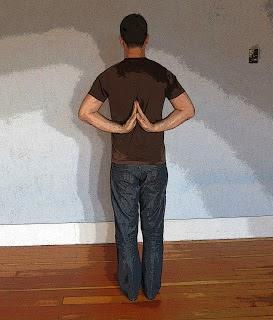 Stay in the pose for approximately 30 seconds, working up to 2 minutes. To come out of the pose, carefully wiggle your hands down your back at least six inches or so before you release your hands down by your sides.
Stay in the pose for approximately 30 seconds, working up to 2 minutes. To come out of the pose, carefully wiggle your hands down your back at least six inches or so before you release your hands down by your sides.If you attempt version 1 and are unable to turn your fingertips up and keep them together, there may be too much tightness or tension anywhere from your shoulders to your wrists that prevents you from doing this safely. Choose version 2 instead (see Featured Pose: Reverse Namaste ).
10. Bridge Pose (Setubanda Sarvangasana), 30 seconds to 1 minute. From Constructive Rest position (on your back with knees bent and heels about four inches from your hips), establish the normal, slightly arched shape of your lumbar spine. Then lift your hips straight up as you push down into your feet, like an elevator going up a few floors, maintaining the neutral arch of the lower back. Once in Bridge pose, bring some focus to your arms. Press the upper back of your upper arms (right where your arms meets the shoulders) down into the floor firmly while actively lifting the lower tip of your breast bone up to the sky. Then press your arms, which are lengthening towards your feet, down firmly into the floor as well. This will begin to encourage extension of your shoulder joints. To come down, lower your hips straight down, like an elevator returning to the lobby floor. Rest for a moment in Constructive Rest position, and repeat one more time.
 11. Upward Plank Pose (Purvottanasana), 30 seconds to 1 minute. See Featured Pose: Upward Plank for instructions on how to practice this pose.
11. Upward Plank Pose (Purvottanasana), 30 seconds to 1 minute. See Featured Pose: Upward Plank for instructions on how to practice this pose.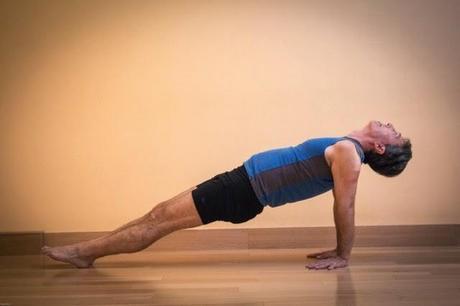 Rest briefly in Constructive Rest pose (on your back, with knees bent, soles of the feet on the floor about hip-width apart, and knees dropping in toward each other) and then repeat the pose.
Rest briefly in Constructive Rest pose (on your back, with knees bent, soles of the feet on the floor about hip-width apart, and knees dropping in toward each other) and then repeat the pose.12. Lord of the Fishes Pose (Ardha Matseyendrasana), 1 minute per side. Although this twist is one of the most complex to get into, I’m including it in this sequence because from my experience it’s one of the most effective all-over twists I’ve ever practiced. Yes, it just feels so good!
We don’t yet have full instructions on how to practice this pose, so for now I’ll just be brief. But I will say that the best way to get into this pose is to break it down into two phases: first, set up your leg position and, second, move into the twist.
Unless you are very flexible, sit on the edge of a folded blanket or another support, and then bend your knees and place the soles of your feet on the floor. Now bending your left leg even more, bring your left foot as close as possible to your right sitting bone. Then step your right foot over your left knee, with the toes of your right foot a few inches in front of your left knee.
Now get ready to twist to your right. Inhale and lengthen your spine, from sitting bones to the crown of your head. Then, instead of moving from your head, initiate the twist from your lower spine and the portion your abdomen that is just above your navel, while keeping your lower abdomen relaxed. As you move into the twist, bring your left arm either around your right knee or bring your left armpit over your right knee and move your left forearm and hand into an upright position. Allow your neck and head to complete the twist only if that feels comfortable for your neck.
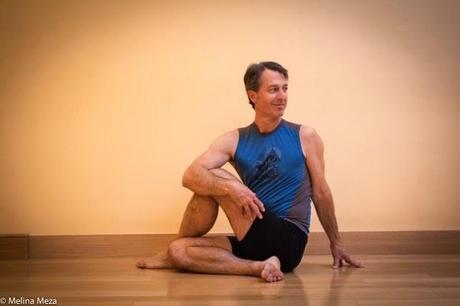 To come out of the pose, release the twist and bring your torso and head back to center. Then, one at a time, step your feet back into your starting position and repeat the pose on the other side.
To come out of the pose, release the twist and bring your torso and head back to center. Then, one at a time, step your feet back into your starting position and repeat the pose on the other side.13. Relaxation Pose (Savasana), 10 to 20 minutes. Practice any form of Savasana you like, either the classic version flat on the floor or any supported variation (see Savasana Variations). The important thing is to be entirely comfortable, so discomfort or pain doesn’t distract you from being able to relax completely. Then chose a mental focus for the practice. A mental focus is crucial because if you just lie there and fret about the past or worry about the future, you won’t trigger the Relaxation Response (and besides a mental focus is what makes Savasana, Savasana and not just lying there). See Savasana (Corpse Pose)for complete information on how to practice Savasana.
 Subscribe to Yoga for Healthy Aging by Email ° Follow Yoga for Healthy Aging on Facebook ° Join this site with Google Friend Connect
Subscribe to Yoga for Healthy Aging by Email ° Follow Yoga for Healthy Aging on Facebook ° Join this site with Google Friend Connect

